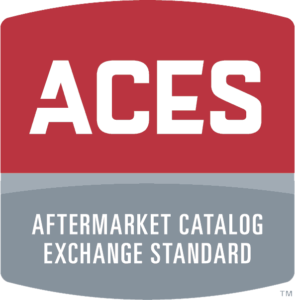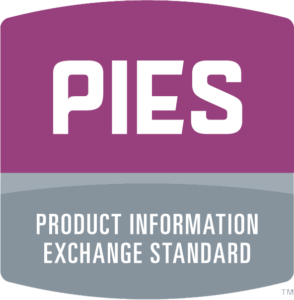What Is ACES and PIES data?

- ACES and PIES are standardized data formats, exclusive to the automotive industry.
- ACES (Aftermarket Catalog Exchange Standard) supports automotive application (fitment) data.
- PIES (Product Information Exchange Standard) supports product (part number) data.
In this article we look at the two leading industry standards for data formatting in the automotive aftermarket industry. These two data standards, of course, being ACES and PIES. The Auto Care Association created the ACES and PIES data standards. This trade association was formerly known as the Automotive Aftermarket Industry Association, or AAIA.
How ACES and PIES data works in the automotive aftermarket
These data standards work together to manage and exchange part number and fitment data to subscribers. It also gives the automotive aftermarket industry a universal standard to work with. So why have ACES and PIES become the industry standards that are used today as many as 535,000 business members? To understand that, we need to take a deeper look. Let’s dig into the definitions of the ACES and PIES information exchange standards.
ACES (sometimes incorrectly called AAIA ACES) and PIES (sometimes incorrectly called AAIA PIES) show how our industry is different from other industries. We have to manage year, make, model fitment data for products. This presents unique challenges to companies exchanging data. This data helps create websites, sell online or in a retail store, or helps warehousing products. These data standards were created by the Auto Care Association when the association was still called Automotive Aftermarket Industry Association (AAIA).
What is ACES data and how does it define automotive parts data?
 ACES
(Aftermarket Catalog Exchange Standard) is the automotive aftermarket
industry standard for managing and exchanging automotive catalog
applications data. Aftermarket manufacturers can send and receive parts
data using industry standard vehicle applications. This includes year,
make, model, part types and qualifier statements.
ACES
(Aftermarket Catalog Exchange Standard) is the automotive aftermarket
industry standard for managing and exchanging automotive catalog
applications data. Aftermarket manufacturers can send and receive parts
data using industry standard vehicle applications. This includes year,
make, model, part types and qualifier statements.
The standard includes part data (brand, part number, part type), along with application fitment information. That application fitment defines which vehicle, which vehicle attributes, and which position on the vehicle the part fits. “Fitment” can cover vehicle make, model, year, submodel, engine, transmission, truck bed length, and so on.
ACES data files come in an XML format and can be used after paying a subscription fee to the Auto Care Association. To be specific, the ACES format is a nested XML file, with only one file per brand. The current ACES data file is ACES 4.2, revision 1, released July 2021.
Who maintains ACES data?
The Auto Care Association maintains ACES files, using the guidance of the Auto Care Association’s Technology Standards Committee. They also update the vehicle applications database. This application database is known as VCdb for “Vehicle Configuration Database.” Monthly updates keep it current. Vehicles as far back as the 1896 model year if manufactured in the United States, 1942 (Canada) and 1961 (Mexico) are included in the VCdb. Powersports fitments go as far back as the 1920 model year (United States) or 2015 (Mexico). The latest ACES update now includes vehicles sold in Latin America, including light, medium and heavy duty vehicles in Argentina, Bolivia, Brazil, Chile, Colombia, Costa Rica, Dominican Republic, Ecuador, Guatemala, Panama, Paraguay, Peru, and Uruguay.
 ACES data standard and associated data tables, courtesy Auto Care Association
ACES data standard and associated data tables, courtesy Auto Care Association
The vehicle table contains over 60,000 specific combinations of year/make/model cars and trucks. The VCdb covers a total of nine additional vehicle categories: RV, railway, power generation, marine auxiliary and marine propulsion, lawn and garden, industrial, construction, and agriculture. For example, as of January 2023, the standard covers 32,353 motorhome and recreational vehicles manufactured in the US and Canada.
Parts that are universal and don’t have a specific fitment will not have ACES data. Think of ACES as the link between a part number and a specific vehicle in the VCdb.
There are two subscription levels for the VCdb. One covers automobiles and light duty trucks GVW 1 through 3. It also covers powersports including ATVs, personal watercraft and motorcycles. Another subscription covers medium- and heavy-duty trucks for GVW classes 4 through 8.
The Product Classification database (PCdb) is also part of the ACES standard. It contains a standard list of part types and categories, such as “piston” for example. It covers collision repair parts, replacement parts, service repair parts and aftermarket supplies. To access the PCdb, as of January 12, 2023, you must have a subscription to the Product Attribute database (PAdb) or the Vehicle Configuration database (VCdb).
Aftermarket parts suppliers are encouraged to validate their parts data fitment against the ACES industry standard to ensure correct fitment information. Missing vehicle fitment information is called an application hole, or “app hole.”
What is PIES data for automotive parts?
 PIES
(Product Information Exchange Standard) is the automotive aftermarket
industry standard for managing and exchanging product data of automotive
parts and accessories. PIES data includes over 20,000 product types.
Twenty-five product categories organize all 20,000 product types.
PIES
(Product Information Exchange Standard) is the automotive aftermarket
industry standard for managing and exchanging product data of automotive
parts and accessories. PIES data includes over 20,000 product types.
Twenty-five product categories organize all 20,000 product types.
Unlike ACES, PIES data standards don’t require a subscription. However, there are additional databases that work with PIES data that are available only by subscription. To access the PIES data you must have a subscription to at least one ACES VCdb and the PAdb.
 The PIES data standard and associated tables, courtesy Auto Care Association.
The PIES data standard and associated tables, courtesy Auto Care Association.
As with ACES, the Auto Care Association publishes PIES standards. The standard part type taxonomy is part of the PCdb table they publish, covering product classifications. PIES files not only include product attributes, but also includes data like brand ID, prices, dimensions, weights, kits, digital assets, marketing content, UPC codes, hazardous material information and country of origin. The most current standard is PIES 7.2, revision 7, released March 7, 2024.
PIES data includes information on brands, which follow a standardized structure as with the other PIES fields. Private brands can be included in a PIES file by using the brand owner name, or the retailer’s name.
You can download the latest PIES 7.2 technical specifications by visiting this page and scrolling to the bottom, or here is a direct link to the PIES release notes as of April 2024, hosted on the Auto Care Association website.
PIES database tables summary
The PIES standard includes the Product Classification Database (PCdb), the Brand Table, and the Product Attribute Database (PAdb). Some of these are also linked to the ACES standard, described earlier on this page. PIES files link to digital assets such as images, they don’t contain the actual digital assets.